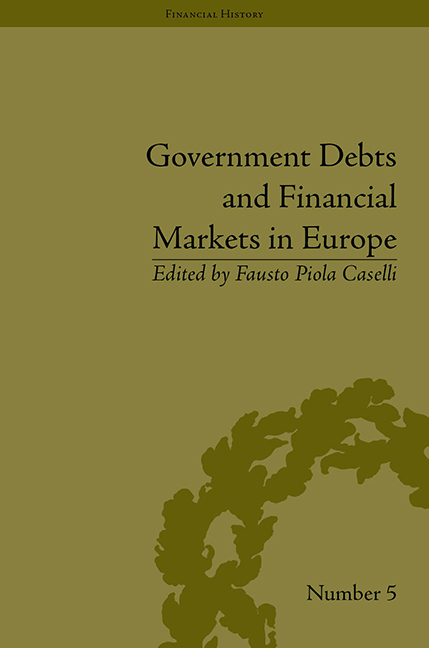Book contents
- Frontmatter
- CONTENTS
- Contributors
- List of Charts and Tables
- Introduction
- 1 The Financial Administration of North Hanseatic Cities in the Late Middle Ages: Development, Organization and Politics
- 2 Government Debts and Credit Markets in Renaissance Italy
- 3 Government Debts and Financial Markets in Castile between the Fifteenth and Sixteenth Centuries
- 4 Government Debt and Financial Markets: Exploring Pro-Cycle Effects in Northern Italy during the Sixteenth and the Seventeenth Centuries
- 5 Government Policies and the Development of Financial Markets: The Case of Madrid in the Seventeenth Century
- 6 The Role Played by Short-Term Credit in the Spanish Monarchy's Finances
- 7 From Subordination to Autonomy: Public Debt Policies and the Creation of a Self-Ruled Financial Market in the Kingdom of Naples in the Long Run (1500–1800)
- 8 Public Debt in the Papal States: Financial Market and Government Strategies in the Long Run (Seventeenth–Nineteenth Centuries)
- 9 Towards a New Public Credit Policy in Eighteenth-Century Spain: the Introduction of the Tesorería Mayor de Guerra (1703–6)
- 10 French Public Finance between 1683 and 1726
- 11 Long-Term War Loans and Market Expectations in England, 1743–50
- 12 Mercantilist Institutions for the Pursuit of Power with Profit: The Management of Britain's National Debt, 1756–1815
- 13 Italian Government Debt Sustainability in the Long Run, 1861–2000
- 14 Times of Wasteful Abundance: The Apogee of the Fiscal State in the Federal Republic of Germany from the 1960s to the 1980s
- Conclusion: Final Remarks
- Notes
- Bibliography
- Index
11 - Long-Term War Loans and Market Expectations in England, 1743–50
- Frontmatter
- CONTENTS
- Contributors
- List of Charts and Tables
- Introduction
- 1 The Financial Administration of North Hanseatic Cities in the Late Middle Ages: Development, Organization and Politics
- 2 Government Debts and Credit Markets in Renaissance Italy
- 3 Government Debts and Financial Markets in Castile between the Fifteenth and Sixteenth Centuries
- 4 Government Debt and Financial Markets: Exploring Pro-Cycle Effects in Northern Italy during the Sixteenth and the Seventeenth Centuries
- 5 Government Policies and the Development of Financial Markets: The Case of Madrid in the Seventeenth Century
- 6 The Role Played by Short-Term Credit in the Spanish Monarchy's Finances
- 7 From Subordination to Autonomy: Public Debt Policies and the Creation of a Self-Ruled Financial Market in the Kingdom of Naples in the Long Run (1500–1800)
- 8 Public Debt in the Papal States: Financial Market and Government Strategies in the Long Run (Seventeenth–Nineteenth Centuries)
- 9 Towards a New Public Credit Policy in Eighteenth-Century Spain: the Introduction of the Tesorería Mayor de Guerra (1703–6)
- 10 French Public Finance between 1683 and 1726
- 11 Long-Term War Loans and Market Expectations in England, 1743–50
- 12 Mercantilist Institutions for the Pursuit of Power with Profit: The Management of Britain's National Debt, 1756–1815
- 13 Italian Government Debt Sustainability in the Long Run, 1861–2000
- 14 Times of Wasteful Abundance: The Apogee of the Fiscal State in the Federal Republic of Germany from the 1960s to the 1980s
- Conclusion: Final Remarks
- Notes
- Bibliography
- Index
Summary
In the eighteenth century, debt financing enabled England successfully to muster war resources against an enemy of larger size and set the path towards its empire. Previous studies do not focus on the composition of this debt. This paper focuses on the debt financing of the War of the Austrian Succession (1743–8) that set the stage for the financing of subsequent wars in the eighteenth century. It is shown that deficits were financed by long-term debt in each year of the war when the interest rate was high. A critical feature of the debt policy was the issuance of callable bonds. At the end of the War of the Austrian Succession, the rapid decrease of the interest rate allowed the government to exercise the callable option and to lower the debt service. The callable feature was thus an important contribution to the low debt service that enabled England to issue more debt than France for an interest service that was about the same.
In November 1749, Prime Minister Henry Pelham presented his plan to reduce the interest rate on the debt from 4 to 3 per cent. Dickson gives him much credit in carrying this difficult project without market disruption. By contrast in France, when the abbé Terray reduced the interest rate on some government liabilities in 1770, the price of the marketed debt fell by half. An interest reduction was considered a default in France but it was accepted in England because of the type of debt contract: all long-term debt in England was in callable bonds.
There is a view that war deficits were financed by short-term and refinanced by long-term instruments after the war, when the interest rate was lower. This view does not hold for the War of the Austrian Succession or the Seven Years War (1756–63). Even in the War of American Independence (1777–83) short-term debt was a minor part of financing.
- Type
- Chapter
- Information
- Government Debts and Financial Markets in Europe , pp. 167 - 178Publisher: Pickering & ChattoFirst published in: 2014



